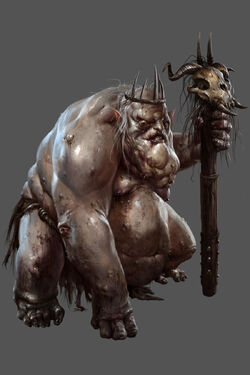|
Ogrod
| |
|
| |
|
Titles
|
The Great Goblin, or Dûrba-Hai in Orcish
|
|
Location
|
|
|
Language
|
|
|
Birth
|
Unknown
|
|
Death
|
T.A. 2941
|
|
Gender
|
Male
|
Ogrod, the Great Goblin, was the Lord of Goblin-town and chieftain of the Goblins of Goblin-town of the central Hithaeglir as of T.A. 2941.
Biography[]
Like many of his predecessors, Ogrod was an unusually large Orc, as he was of the progeny of Ogslap, who slew his rivals for the throne of Goblin-town. Due to his tremendous size, Ogrod was able to survive the bloody power struggles common among Orcish tribes and finally assumed the title of "The Great Goblin", or Dûrba-Hai in Orcish.
Ogrod was known to have had Boldog blood, evidenced by his gargantuan stature, more than twice the height of all of his minions and his immense, even obese, form, with his bulbous head which seemed too large for his body, from which swayed a beard-like flesh growth. Although Ogrod was known for his cleverness, cautiousness, and surprising charisma, his explosive temper and swollen ego often troubled his reign.
Unknown to many of his royal advisers, Ogrod secretly bent the knee to the Necromancer. Those of Ogslap's line had long served the purposes of the Dark Lord and been handsomely rewarded for their fealty. Ogrod was no exception, and he used this as a tool in keeping his own kingdom autonomous of Bolg of the North. Knowing war in several years would be imminent, the Great Goblin planned to raid the villages of Woodmen to capture slaves and as a testimony of his commitment to the Necromancer's cause.
Ogrod was described in Bilbo Baggins' autobiographical work There and Back Again, in which he was seen taking the company of Thórin Oakenshield captive, accusing them of being spies, thieves, murderers, and friends of Elves. He was finally slain by Gandalf, allowing the Dwarves to escape and the Quest of Erebor to continue.
The slaying of Ogrod reignited the ancient enmity which existed between the Dwarves and the Orcs, causing their many disparate tribes to unite and make preparations for war to secure their domination of the North. A host of Orc tribes loyal to Ogrod assembled at Mount Gundabad and intended to sweep southward until they learnt of the death of Smaug the Terrible and altered their plans. Ogrod's death ultimately precipitated the Battle of Five Armies when the host of Orcs encountered the famed Dwarven warrior, Dáin Ironfoot, upon their arrival at Erebor; further, Sauron's hold over the Goblins was weakened and hope of possibly using Ogrod's followers against the Northmen and Elves foiled.
Inventory[]
In life, Ogrod wore the great-sword Elfhewer. Otherwise, his only described items were a crude staff with an animal skull and a makeshift crown made from animal teeth.
See also[]
References[]
- MERP: Lords of Middle-earth Vol III: Hobbits, Dwarves, Ents, Orcs & Trolls
- The Hobbit: The Prelude to The Lord of the Rings (Videogame)

